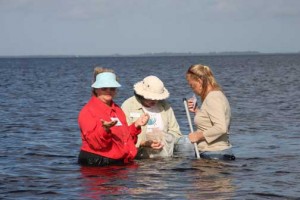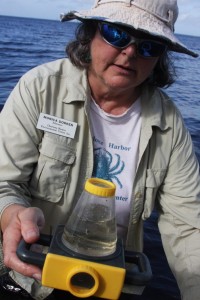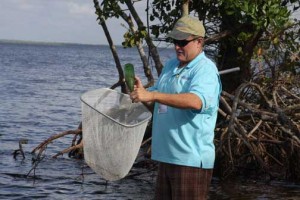What’ in a wading trip? Get wet, get happy, learn new things. Are we fourth graders on a field trip? Heck no.
We are adults at the annual Florida Outdoor Writers Association Conference held last week in Punta Gorda – yes, we are fully-grown, allegedly responsible people who have elected to go on a wading trip.
I kid you not – they gave us plastic buckets. My plastic beach bucket is a swirly pink and white with a shovel attached. It is charming. I feel four-years old again and ready for the beach. Other pails are purple or yellow. We got them as gifts from the Charlotte Harbor Visitor’s Bureau to take with us on a wading trip.
Giggling, we pick up our buckets and head for the water’s edge.
Wading trip is a sea grass adventure up to your kneecaps
We are at Ponce de Leon Park in Punta Gorda, Florida. The park faces Charlotte Harbor and is somewhat of a miracle. It was slated to be condos. Instead it is saved for the public to appreciate the tidal zones and marshes, a piece of authentic Florida.
Gingerly, we wade into Charlotte Harbor. Most of us are wearing crocs or sneakers because the sandy bottom has oyster shells that can rip open bare feet. The tide is out. Some of us are dragging what looks like a butterfly net on long pole along the bottom, scooping up algae, shrimp, a hermit crab in a periwinkle shell. It is something different with every scoop.

Monica Dorken (center) explains finds from the bottom of Charlotte Harbor to FOWA members Sandy Huff (left) and Karen Smith (right). Photo by Lucy Beebe Tobias
Monica Dorken, our guide from the Charlotte Harbor Environmental Center, wears a weather-beaten hat. We knew immediately she had to be our guide even before seeing her nametag. An old hat is required guide attire.
The brave ones in the group wade out deeper. Water is up to their waists, then practically to their shoulder! Those of us with cameras hang back; reluctant to get inn over our knees, worried about dropping the camera.
Monica tells us about all the fourth graders she’s taken on these field trips, and I’m thinking, why should kids have all the fun? Why indeed. Let’s get wet and wild.
Wading trips a great way to learn new things about Florida
She brings out a cool viewer – put in some salt water and anything you’ve found, look through the viewer and a shrimp becomes gigantic.
The Center does these trips for free and sometimes schedules them for adults. Check their calendar.
In another lifetime I wanted to be a marine biologist and study the inter tidal zone. But life has a way of happening when you are making other plans. It feels great to be back in the intertidal zone. So much action here – the food web at work, with meals changing with the tides.
On this day, I’m amazed, once again, at how everything is connected. What runs off our lawns into the bays and oceans affects life there. Monica brings some really cool magnifying viewers. Put in some seawater and look inside. A small shrimp become gigantic.
Even trash has an effect on the environment. FOWA member Rodney Smith finds a green glass bottle in the water and shakes it to see if any small crabs are living inside.
A yellow-crowned night heron lands on a mangrove limb. Writer/author Sandra Friend captures the moment on camera. Her husband, cartoonist Rob Smith, sits on a tree limb, sketching nearby mangroves.
Before we got wet, Margo gave a talk on all the things we might see before we got wet on our wading trip. We handle a whelk egg case and starfish. It is not our day to find these things in the water. But no matter. We leave soaked and satisfied. When is the next field trip? I’m ready. I’ve got my plastic bucket.
Lucy Beebe Tobias is a member of FOWA and the author of 50 Great Walks in Florida, February, 2008, University Press of Florida. ©2008 Lucy Beebe Tobias. All rights reserved.
More to Explore
Paddling and floating in Florida

